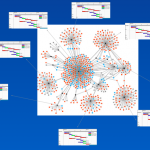When you really think hard about it, everything we do of any relevance is a project. With the exception of repetitive processes, e.g. bookkeeping, whether it’s creating something from scratch, manufacturing a product, on-boarding a new employee or pitching to a new customer, all these activities require resources with certain competencies to carry out tasks that have to be scheduled to produce a desired result within a timeframe and budget.
What does this this mean for organizations?
Understanding that operationally an organization is, in fact, a network of projects helps us see organizations in a completely new way. It means we can free ourselves of the artificial limitations of a traditional hierarchical/functional organization structure. This doesn’t mean, as we’ve said before, that we have to throw away completely the notion of hierarchy – we need to understand it differently. Instead of a vertical structure with silos that prevent the work of organizations from flowing as it should, we have various levels of projects that dip into the pool of competencies available within the organization as they are needed. In some projects a person will be a project manager, and that same person might lend their competencies to another project as a resource. The ‘hierarchy’, then, is of responsibility: the bigger the project the greater the responsibility of the project manager. The CEO, in this context, becomes the project manager of the project managers.
What does this mean for project managers?
The organization as a network of projects is a model that requires first class project management. It needs project managers that have much more than a certificate for a technique. They must have a deep understanding of what it means to manage the complex human activity of projects, (see. How Can We Solve the Urgent Crisis in Project Management?’
PMs have to be conscious of the fact that resources are not infinite and errors often occur in project management because this is not taken sufficiently into account. In the Theory of Constraints, projects are scheduled based on the finiteness of resources and this is called “Critical Chain,” as opposed to the well-known “Critical Path.
Critical Chain requires PMs to understand that wrong behaviors and mental habits like multitasking and putting issues off until the last minute (“student syndrome”) slow down artificially the completion of projects. We must not protect individual tasks but the project as a whole, so there should be no milestones.
Another critical threat to project completion comes from delays caused by resistance to the change the project brings and conflicts arising from it. This is where the PM needs to be a much more rounded professional figure, capable of working with people to develop what we like to refer to as ‘intelligent emotions’, to overcome resistance to desired change and finding win-win solutions to inevitable conflicts. For this purpose Dr. Goldratt developed the Thinking Process Tools. In other words, Project Managers become some of the most important resources that an organization has within it.
Sign up to our blog here and shift your thinking towards broader, systemic possibilities for yourself and your organization.
About the Author
Angela Montgomery Ph.D. is Partner and Co-founder of Intelligent Management and author of the business novel+ website The Human Constraint . This downloadable novel uses narrative to look at how the Deming approach and the Theory of Constraints can create the organization of the future, based on collaboration, network and social innovation. She is co-author with Dr. Domenico Lepore, founder, and Dr. Giovanni Siepe of ‘Quality, Involvement, Flow: The Systemic Organization’ from CRC Press, New York.






Hi Angela,
Very nice re-visulaization of the organizational structure.
Best – John
Thank you, John!
I subscribe to the “pretty much everything is a project” approach, since for example on-boarding (I _hate_ that word….) an employee meets the criterion of uniqueness, and it’s worth treating each on-boarding episode as different from the others. (Even though it’s almost certainly going to follow the same checklist as the last episode.)
But to my point: I just need to check my understanding on the silo thing. I worked for a company that did a 6-monthly national stock-take. Each one was a project: same checklist as last time, but a team was assembled each time from national finance, national logistics, local region and branch management and so on. That meets your explanation of cutting across the silos, and was a very necessary cross-functional approach to getting the project done. An easy example: the cross-functional team counted stuff and produced a report of findings; project over.
But let’s go back to the new employee on-boarding. Your approach suggests to me that those involved in a new hire, and here I’m guessing that could be the manager with the need, perhaps that department’s internal customers (who actually might have set the ball rolling with a turnaround issue), HR, payroll, security whatever, temporarily “forget” their allegiance to say HR etc and communicate with each other “through the project”, across the silos, rather than following the “chain of command” up their own silo, across to the next one, and down again to their peer with whom they could more easily have communicated directly?
Unless I’m missing something, isn’t that just Matrix Management, with each row being a Project? The only difference, to me, is that you’re suggesting more rows than before, since things which weren’t previously named Project (with a capital-P) are now treated as such.